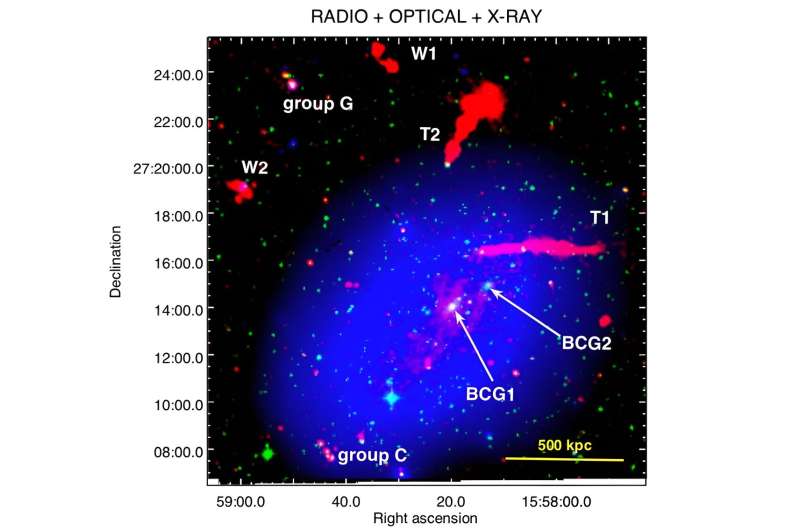August 23, 2023 report
This article has been reviewed according to Science X's editorial process and policies. Editors have highlighted the following attributes while ensuring the content's credibility:
fact-checked
preprint
trusted source
proofread
European astronomers detect new component of radio halo in a nearby galaxy cluster

Using the LOw Frequency ARray (LOFAR), astronomers from the University of Bologna, Italy and elsewhere, have conducted radio observations of the nearby galaxy cluster Abell 2142. In result, they detected a new component of the cluster's giant radio halo. The finding was presented in a paper published August 15 on the pre-print server arXiv.
Galaxy clusters contain up to thousands of galaxies bound together by gravity. They are the largest known gravitationally bound structures in the universe, and could serve as excellent laboratories for studying galaxy evolution and cosmology.
Radio halos are enormous regions of diffuse radio emission, usually found at the centers of galaxy clusters. However, diffuse emissions generally have very low surface brightness, particularly at GHz frequencies, which makes them hard to detect. Their brightness increases at lower frequencies, unveiling the presence of these regions. One of the best instruments to study radio haloes at low frequencies with unprecedented detail and sensitivity is LOFAR—due to its capability of obtaining deep, high-resolution, high-fidelity and low-frequency radio images.
Located some 1.24 billion light years away, Abell 2142 (or A2142 for short) is a nearby X-ray luminous galaxy cluster. It contains at least 900 galaxies (within a radius of approximately 11.4 million light years) that are hierarchically organized in many structures and sub-structures typically consisting of small groups.
Previous radio observations of Abell 2142 have found that it hosts a giant radio halo with two components, named H1 and H2, which are characterized by different morphological and spectral properties. H1, also known as the "core" is the brighter, more company and roundish out of the two. When it comes to H2, or the "ridge," it is larger than H1, fainter, and showcases an elongated shape.
Recently, a team of astronomers led by University of Bologna's Luca Bruno has decided to take a closer look at the radio halo in Abell 2142 using LOFAR. The study, complemented by archival multi-frequency radio and X-ray data, provided more insights into the structure of this halo.
LOFAR observations have unveiled the presence of the radio halo's third component—H3. The results indicate that H3's radio emission follows the X-ray thermal distribution of the intracluster medium (ICM) up to scales greater than 6.5 million light years.
H3 has dimensions of about 7.8 by 6.5 million light years, spectral index of 1.57, and showcases exponential surface brightness profile, as well as sub-linear radio/X-ray spatial correlation. These findings allowed the team to classify H3 as a giant ultra-steep spectrum radio halo.
Trying to explain the origin of H3, the authors of the paper offer two hypotheses. They suppose that H3 may be a result of an old energetic merger or inefficient turbulent re-acceleration induced by ongoing minor mergers.
"In both these two scenarios, H2 could have been the inner part of H3, which has then been reshaped by turbulence into the present ridge," the researchers concluded.
More information: L. Bruno et al, A three-component giant radio halo: the puzzling case of the galaxy cluster Abell 2142, arXiv (2023). DOI: 10.48550/arxiv.2308.07603
Journal information: arXiv
© 2023 Science X Network





















